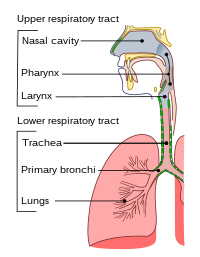
Photo from wikipedia
Two new series of ring-opened analogues of cromakalim bearing sulfonylurea moieties (series A: with N-unmethylated sulfonylureas, series B: with N-methylated sulfonylureas) were synthesized and tested as relaxants of vascular and… Click to show full abstract
Two new series of ring-opened analogues of cromakalim bearing sulfonylurea moieties (series A: with N-unmethylated sulfonylureas, series B: with N-methylated sulfonylureas) were synthesized and tested as relaxants of vascular and respiratory smooth muscles (rat aorta and trachea, respectively). Ex vivo biological evaluations indicated that the most active compounds, belonging to series B, displayed a marked vasorelaxant activity on endothelium-intact aortic rings and the trachea. A majority of series B compounds exhibited a higher vasorelaxant activity (EC50 < 22 μM) than that of the reference compound diazoxide (EC50 = 24 μM). Interestingly, several tested compounds of series B also presented stronger relaxant effects on the trachea than the reference compound cromakalim (EC50 = 124 μM), in particular compounds B4, B7 and B16 (EC50 < 10 μM). By contrast, series A derivatives were poorly active on aortic rings (EC50 > 57 μM for all, and EC50 > 200 μM for a majority of them), but some of them showed an interesting relaxing effect on trachea (i.e. A15 and A33, EC50 = 30 μM). The most potent compounds of both series, i.e. A15, A33 and B16, tested on aortic rings in the presence of glibenclamide or 80 mM KCl, suggested that they acted as voltage-gated Ca2+ channel blockers, like verapamil, instead of being ATP-potassium channel activators, as is cromakalim, the parent molecule. Further investigations on cultured vascular smooth muscle cells showed a strong stimulating effect on elastin synthesis, especially compound B16, which was more active at 20 μM than diazoxide, a reference ATP-sensitive potassium channel activator. Taken together, our results show that the N-methylation of the sulfonylurea moieties of ring-opened cromakalim analogues led to new compounds blocking calcium-gated channels, which had a major impact on the arterial and tracheal activities as well as selectivity.
Journal Title: European journal of medicinal chemistry
Year Published: 2018
Link to full text (if available)
Share on Social Media: Sign Up to like & get
recommendations!